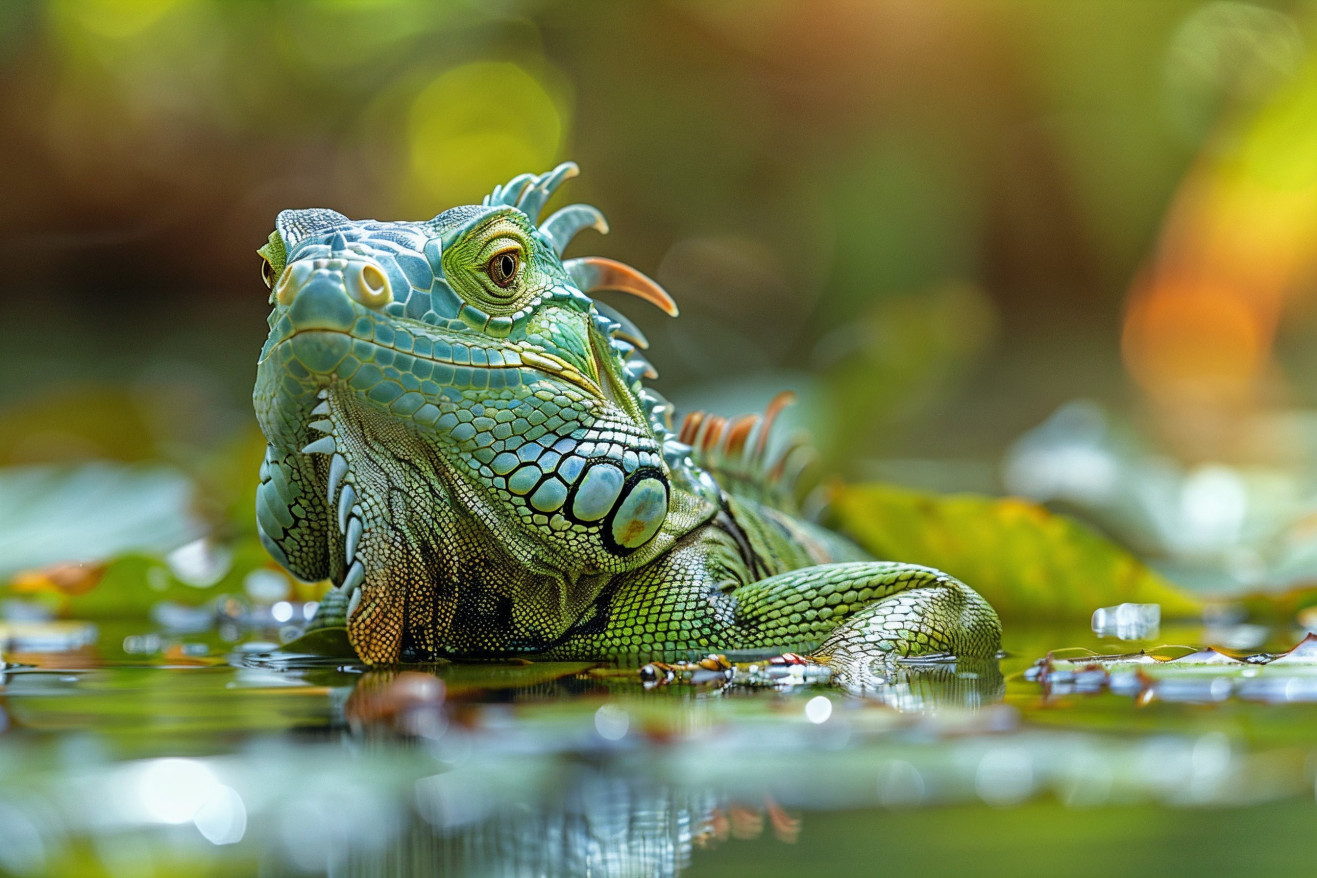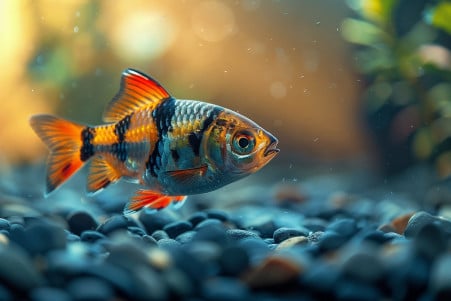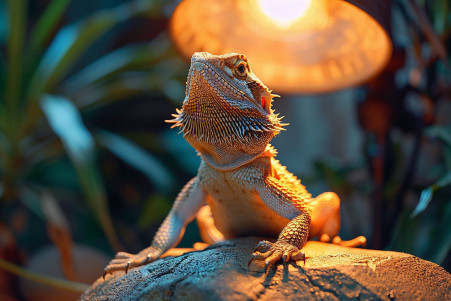Do Lizards Swim? The Science of Lizards’ Aquatic Adaptations
19 March 2024 • Updated 17 March 2024

From basking on rocks to swimming through water, the skills of lizards are more varied than you might think. Many species of lizards are adept swimmers. Chinese water dragons and water monitors use their tails to swim, and green basilisk lizards can even run across the water. Physical adaptations like webbed feet and the ability to re-breathe air enable them to be better swimmers.
This article will explore the many ways that lizards have adapted to swimming by looking at both zoological observations and biological studies that have documented their physical and behavioral adaptations to aquatic life.
It will also look at ecological implications, specifically how these adaptations impact the roles that lizards play in their ecosystems. By the end of this article, you will have a well-rounded view of the world of lizards, and you will have a newfound appreciation for their ability to do more than just survive on land.
Do lizards swim?
Masterful Swimmers: Lizards and Their Aquatic Artistry
The diversity of lizards has resulted in a wide range of swimming styles and adaptations, all of which demonstrate the reptiles’ ability to evolve. For example, the Chinese water dragon uses its tail to propel itself through the water, where it is much faster than it is on land, according to Reptile Kingdoms.
Meanwhile, the green basilisk lizard, also known as the Jesus Christ lizard, can run on the surface of the water using special fringes on its toes, according to National Geographic.
Chameleons, which are not natural swimmers and only encounter water by accident or when pursuing a mate, can inflate their bodies to float and use their legs to paddle. The marine iguana, meanwhile, can hold its breath for long periods to dive into the ocean and find food.
Anolis lizards have even evolved a behavior called ‘rebreathing’ to survive in their semi-aquatic environment. According to a paper in Current Biology, when these lizards exhale, they expel air into a bubble that sticks to their snouts.
They can then inhale the air in the bubble, which is similar to the way a scuba diver breathes underwater. This rebreathing behavior is just one example of the many ways that lizards have evolved to thrive in the water, which has helped them avoid predators and become more involved in aquatic environments.
Into the Water: The Physiology and Anatomy of Aquatic Lizards
Aquatic lizards have a number of physiological and anatomical adaptations that enable them to swim. For instance, the bodies of many aquatic lizards are more streamlined than those of their terrestrial counterparts, which reduces drag and makes it easier for them to move through the water.
A spotlight on ResearchGate explains that some of the other adaptations that enable aquatic lizards to swim include valved nostrils, which allow them to breathe while keeping water out of their lungs, and the presence of tentacles or chin barbels in some species, which help them sense their surroundings while they’re underwater.
Lizard muscles are also adapted for swimming. Tail anatomy is particularly important for both propulsion and steering, and many aquatic lizards have tails that are laterally compressed so they can move through the water more easily. Meanwhile, a paper emphasizes that cutaneous respiration, which enables lizards to breathe underwater through their skin, is important for their survival.
Meanwhile, a paper published in PMC explains that the hydrophobic skin of Anolis lizards helps them with their ‘rebreathing’ strategy, which is essential for staying underwater for longer periods of time without having to come up for air. These physiological adaptations aren’t just important for the survival of individual lizards, they’re also important for the survival of the species and are a key part of their evolutionary history.
Thanks to these adaptations, lizards play important roles in their ecosystems, whether they’re on land or in the water.
Ripple Effects: How Swimming Lizards Impact Their Ecosystems
Swimming lizards act as important links in food chains, connecting aquatic and terrestrial ecosystems. As predators and prey, these reptiles play a key role in their ecosystems.
For example, crocodiles and alligators, as keystone species, impact the ecosystems of a wide range of other species by creating water refuges during droughts, according to Endangered Species International.
Meanwhile, the presence of swimming lizards impacts the growth of vegetation and the population dynamics of spiders, according to a study from Washington State University. This research shows that anole lizards, which have evolved to have shorter legs, can stimulate vegetation growth and significantly reduce spider populations, demonstrating the far-reaching impact of swimming lizards on their ecosystems.
Lizards like the marine iguana, with its unique ability to dive and feed on algae, impact the ecosystem by affecting predator-prey relationships and the health of marine vegetation. They interact with the ecosystem not just to stay alive but to fulfill specific ecological roles.
A closer look at lizards shows that their evolution and the behaviors it has led to have a variety of impacts on the ecosystems they live in. Future studies will explore their behaviors in aquatic environments, where their attraction to water leads to a different side of lizard life.
Swimming With the Fishes: Lizard Behavior in Water
Lizards have evolved a variety of ways to interact with water, using it as both a place to hunt and a refuge from predators. For example, anole lizards have even developed a re-breathing strategy that involves blowing air bubbles to stay underwater and avoid predators for up to 18 minutes, according to Smithsonian Magazine. This is in contrast to their land-based escape strategy of running away.
A study in Behavioral Ecology and Sociobiology showed that when semi-aquatic Anolis lizards dive, they show sex-specific differences in the amount of heat loss and cooling tolerance. Males tend to spend less time underwater than females, which the researchers suggest is to maintain their body temperature for essential activities like defending their territory or mating.
On the other hand, females seem to prioritize avoiding danger over maintaining their body temperature, showing a significant difference in behavior based on sex.
These water-based behaviors, especially the re-breathing strategy, demonstrate the fine line between the need to avoid predators and the physiological costs of being in the water. They also show how lizards have evolved to balance the trade-offs of living in water, which in turn affects their survival and reproductive fitness in their many environments.
Walking on Water: Lizard Thermoregulation in Aquatic Environments
Maintaining a stable core temperature is just as important for lizards in the water as it is for those on land.
However, the physical properties of water create unique challenges for ectotherms.
A paper in the Journal of Comparative Physiology B shows that water monitor lizards, Varanus S. salvator, are able to actively exhibit complex thermoregulatory behaviors by basking in the sun and then retreating to the water to cool down.
The impact of water temperature on lizard physiology is significant. For example, dropping water temperatures can lead to a reduction in the preferred body temperatures of lizards, like those in the study published by PMC, suggesting that there may be a trade-off between thermoregulation and energy conservation.
In addition, dehydration causes lizards to change their thermoregulatory behavior, with lizards in a study published in PLoS One choosing cooler, shadier spots to conserve wateranother balance that lizards must strike.
These physiological and behavioral changes allow lizards to maintain the body temperatures they need to perform activities like foraging and mating, even in the water.
Following the Ebb and Flow of Time: An Evolutionary History of Lizard Aquatics
The evolutionary history of lizard swimming capabilities is a story of adaptation and tenacity. As noted in Evolution: Education and Outreach, the Mesozoic era was home to a variety of marine reptiles, suggesting a long history of aquatic adaptation. Groups like the Sauropterygia and Ichthyopterygia, which had a range of swimming abilities, were abundant in the world’s oceans. The presence of these groups indicates that the aquatic capabilities of lizards have deep evolutionary roots.
According to papers from PubMed and ScienceDirect by Christopher K. Boccia, environmental factors and a lack of resources on land may have led lizards to explore aquatic environments, which in turn led to the development of traits like underwater rebreathing and hydrophobic skin. The fact that these traits have evolved repeatedly in different lineages of lizards is an example of convergent evolution, which is driven by the need to adapt to changing conditions.
Evolutionary biology and the fossil record show that adaptability is a hallmark of lizards. The diversity of swimming capabilities, which likely evolved independently in different lineages, serves as clear evidence of lizards’ ability to adapt to the ever-changing tides of evolution. This story is ongoing, as these adaptations continue to be important for the survival of today’s lizards in aquatic environments.
The Water Dance: Celebrating the Diversity of Aquatic Lizards
In our exploration of the fascinating world of lizards and their aquatic abilities, we have demonstrated the many specializations that enable these reptiles not just to swim but to flourish in water. From the water dragons’ robust, muscular tails to the basilisks’ capacity to run on water, lizards have evolved a broad array of physical and behavioral adaptations to life in the water.
Their breathing, thermoregulation, and hunting adaptations show their incredible flexibility and importance.
The many ways these animals impact their ecosystems—as predators and prey, ecological engineers, and evolutionary wonders—demonstrate the web of life and the value of a variety of survival strategies. In learning about aquatic lizards, we have learned about the complexity of their ecological roles and the larger picture of biodiversity.
In summary, let’s take a moment to appreciate the resilience and adaptability of these amazing swimmers. May they encourage us to continue to learn and conserve so that these amazing animals will be around for generations to come. May this final perspective continue to encourage us to learn about and appreciate the natural world.


